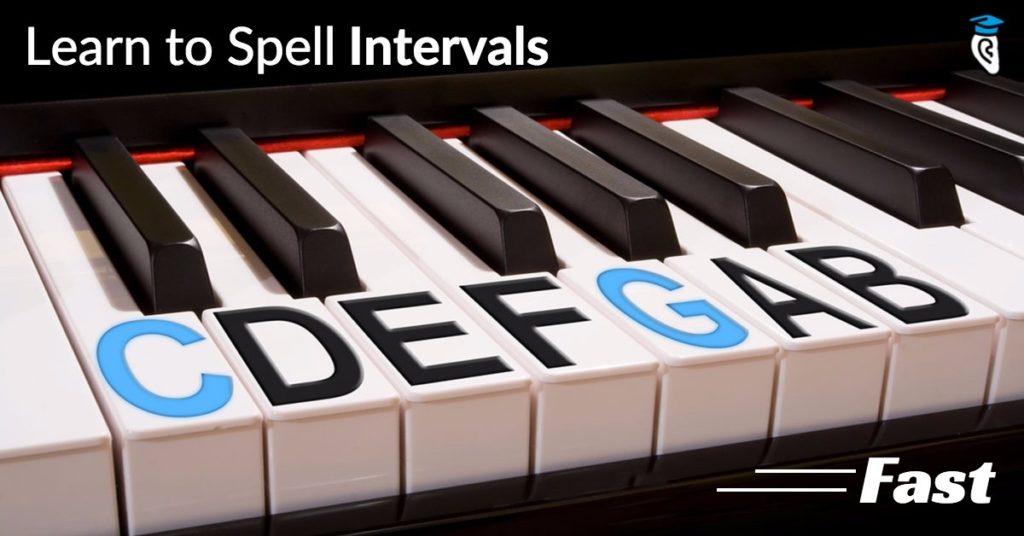Interval recognition is a core skill in ear training, letting you develop a powerful and versatile sense of relative pitch and recognise notes and chords by ear. When you learn to recognise intervals you develop your ear, but you must also train your brain. This means learning to “spell” the intervals with correct note names. This can seem like a huge task at first, but as you’ll see below, there are some handy shortcuts to accelerate the process.
Spelling intervals means that you either take a pair of notes, for example C and the G above, and you can tell what type of interval that is – in this case, a perfect fifth. Or, that you take a note and the interval type, for example a C and “major third”, and know what the other note is to form that interval – in this case, an E.
Interval spellings enable you to apply your interval skills to real musical tasks. You can use your interval recognition skills to play melodies by ear on your instrument, because you know the corresponding note names. You can also sight-sing from written music, or transcribe (write down) the music you hear, using your interval recognition skills.
Learning to spell intervals lets you connect the sound of the interval with your instrument and the notes on the page.
We covered the fundamentals of interval spelling in our previous article, How to Spell Intervals. After reading that tutorial you should be clear on what it means to learn interval spellings – but you might still be wondering about the “how”, or feeling like there’s just too much to memorise.
With 12 root notes, at least 12 interval types, ascending and descending forms, it can feel like an awful lot to try to learn all at once!
Even just the major scale intervals is a big task:
| Interval | ||||||||||||
|---|---|---|---|---|---|---|---|---|---|---|---|---|
| Perfect Octave | D♭ | A♭ | E♭ | B♭ | F | C | G | D | A | E | B | F♯ |
| Major Seventh | C | G | D | A | E | B | F♯ | C♯ | G♯ | D♯ | A♯ | E♯ |
| Major Sixth | B♭ | F | C | G | D | A | E | B | F♯ | C♯ | G♯ | D♯ |
| Perfect Fifth | A♭ | E♭ | B♭ | F | C | G | D | A | E | B | F♯ | C♯ |
| Perfect Fourth | G♭ | D♭ | A♭ | E♭ | B♭ | F | C | G | D | A | E | B |
| Major Third | F | C | G | D | A | E | B | F♯ | C♯ | G♯ | D♯ | A♯ |
| Major Second | E♭ | B♭ | F | C | G | D | A | E | B | F♯ | C♯ | G♯ |
| Root: | D♭ | A♭ | E♭ | B♭ | F | C | G | D | A | E | B | F♯ |
Don’t worry! You actually don’t need to memorise this great big table of answers.
It turns out there are some structures and shortcuts you can take advantage of to learn interval spellings fast.
How to learn interval spellings fast

When you set out to learn intervals you probably imagine a future in which you can instantly answer questions like “What’s a minor seventh above a B♭?” or “What’s the interval between an F♯ and an A?”.
That kind of instant recall should indeed be your goal – but if you try to jump directly there you will find it a very slow and tedious journey.
The first thing to understand if you want to learn interval spellings fast is that there are actually two parts to your task:
- Learn fast how to spell intervals.
- Learn how to spell intervals fast.
This is an important distinction because it’s the combination of the two which normally makes musicians feel overwhelmed when trying to learn to spell intervals.
If you try to learn it all quickly and expect yourself to have instant recall of each spelling, you will soon become frustrated.
So one big tip for learning to spell intervals quickly is: let yourself do it methodically at first, and allow instant recall to develop over time.
Don’t treat interval spellings as a random set of letters and accidentals to simply memorise. Instead, apply some understanding to the spellings, and you can accelerate the process of learning them dramatically.
Our approach will be as follows:
- Learn a process for quickly figuring out an interval spelling.
- Practice applying that process.
- Through real-world application and regular practice, begin to effortlessly memorise more and more spellings for instant recall.
This allows you to quickly learn how to spell intervals – and in time you will also be able to spell intervals quickly.
Note: As you’ll see below, part of our approach involves learning only what you actually need to know. So you’ll find there are some omissions below, for example the more rare interval types. Don’t worry: you can learn those later once you’ve mastered the ones you’ll actually use day-to-day.
Quickly learn how to spell intervals
The process for figuring out interval spellings is simple and it’s essentially the same for both the tasks described above (identifying the note name to complete an interval, and identifying the interval type between two notes).
For simplicity we’ll describe just the process for identifying the note to complete an interval, i.e. answering the question:
“What note is this interval above this starting note?”
This can seem hard at first: the second note could be anything! But actually the answer can always be broken into two simple steps:
- Identify the note letter.
- Identify the appropriate accidental (sharps or flats).
Step One: Identify the note letter

The first step is quite easy. You just need to know your ABCs! Or technically your ABCDEFGs.
The names of the different types of intervals helps us here. What initially can seem like complex and archaic terminology actually gives us clues to how to spell them. You see, the number of the interval tells us how many note names to move through, to spell that interval. This is most easily shown through an example:
Suppose we are starting with the question “What is this interval above a C?”
You know the letter names which follow a C, so just number them:
This tells us that:
- Any second above C is some kind of D
- Any third above C is some kind of E
- Any fourth above C is some kind of F
- Any fifth above C is some kind of G
- Any sixth above C is some kind of A
- Any seventh above C is some kind of B
It doesn’t matter if it’s a major or minor second: it will be some kind of an D.
It doesn’t matter if it’s a major or minor third: it will be some kind of an E.
… and so on!
You can do this for any starting note. Ignore the accidentals. For example if the question is “What is this interval above a B♭?” just use the numbering:
So any second above B♭ is some kind of a C. Any third above B♭ is some kind of a D, and so on.
Now it’s time for step two.
Step Two: Identify the appropriate accidental
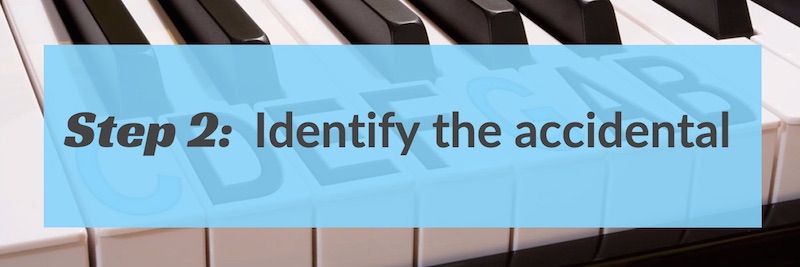
This is where things get a little bit trickier. The full process for identifying the appropriate accidental is based on the number of semitones (a.k.a. half steps) in each interval type:
- Unison
- Minor Second
- Major Second
- Minor Third
- Major Third
- Perfect Fourth
- Augmented Fourth/Diminished Fifth
- Perfect Fifth
- Minor Sixth
- Major Sixth
- Minor Seventh
- Major Seventh
- Perfect Octave
The process is:
- Identify the note letter, as described above.
- Measure the number of semitones between your starting note and that note letter.
- Add accidentals to the note letter in order to match the target interval type.
For example, with the question “What is a minor third above a C?” you first determine that the note letter is an E. Then you count the semitones between C and E, which is four. You know from the table above that a minor third is actually just three semitones. You therefore need to make the E into an E♭ for it to be three semitones above C. So your answer is that a minor third above a C is E♭.
Here’s a second example: “What is a perfect fifth above a B♭?”. You know that the letter name will be four steps beyond B, which is F. The number of semitones between B♭ and F is seven. You know that a perfect fifth is also seven semitones, so no accidental is required! Your answer is that a perfect fifth above a B♭ is an F.
How to make it faster

What we’ve described above is a reliable step-by-step process for figuring out interval spellings.
Can you see how it can also be used to determine the interval type between two notes? Simply count the letter names between the two notes to get your interval type (e.g. “some kind of a third“) and then compare the number of semitones to determine the exact interval spelling (e.g. “there are four semitones so it’s a major third”).
This process works well, and it’s one you can start using immediately. You already know the ABCDEFGs, so you just need to memorise the number of semitones in each interval and you’re ready to put it into action.
The downside of this process is that it’s quite slow! The big problem is counting the number of semitones between two notes. You might do this by imagining a piano keyboard, guitar fretboard, or music staff, but in any case you probably can’t do it instantly.
Fortunately there are several shortcuts you can use to speed up this process.
Interval spelling shortcuts
It’s important to understand the basic process described above. That ensures you always have some way to figure out interval spellings when you need to. But if you’re aiming to spell intervals quickly, you’ll need to take advantage of some shortcuts.
Shortcut #1: Instant accidentals
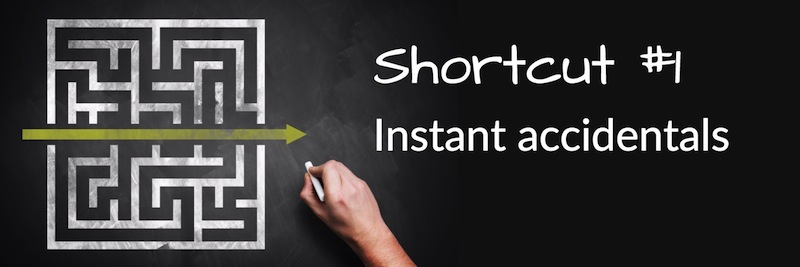
As we explained above, the reason the step-by-step process is slow is that you need to count semitones to determine the appropriate accidental.
What if there was a quicker way to instantly know the correct accidental to use? Then you’d just need to quickly figure out the letter name, apply the correct accidental, and you’d have your answer. Of course you could also use this same skill to determine the right interval type for two notes, since you’d know right away which one matched up with those letter names and accidentals.
There is a set of simple rules you can memorise to tell you the right accidental for each interval type.
By looking at the table shown earlier, you can spot certain patterns in the relationship between the accidental of the root (bottom) note of the interval, and the accidental of the top note. There is a set pattern for each interval type, so you can learn a simple rule for each interval type and immediately know how to spell that interval starting from any note.
Here are the rules, for the intervals of the major scale:
- Major Second: Accidental matches, except root E/B where it’s raised one
- Major Third: Accidental raised one, except root F/C/G where it matches
- Perfect Fourth: Accidental matches, except root F where it’s lowered one
- Perfect Fifth: Accidental matches, except root B where it’s raised one
- Major Sixth: Accidental matches, except for root A/E/B where it’s raised one
- Major Seventh: Accidental raised one except for root F/C where it matches
Simply memorise those rules, and your step-by-step process just became a whole lot quicker!
Here’s an example: suppose you want to know “What’s a major sixth above an A♭?”
First, determine the letter name: count forwards 6 letters (or just backwards 2!) and you get F, so our answer is “some kind of an F”.
Now, using the rules above, you know that for a major sixth the accidental matches, except if the root note is some kind of an A, E or B, where it’s raised one. Our root note is some kind of an A, so we need to raise the accidental from ♭ to natural. So our answer is “F”.
A second example: “What note is a perfect fourth above an F?”. We count letter names forward 4, F-G-A-B, so it’s some kind of a B. Then use the rule “accidental matches, except root F where it’s lowered one” so we lower from the F’s accidental (natural) to flat, giving us B♭ as our answer.
You can probably see how this set of six rules is quicker to learn than all of the different note name and interval type combinations!
Shortcut #2: Use the scale

The other way to instantly know the right accidental without having to count semitones is to use the key signature of the root note. The correct interval spellings will always be based on the key signature.
Looking at the same two examples above:
“What’s a major sixth above an A♭?”: Knowing that the key signature of A♭ major includes B♭, E♭, A♭, and D♭, count letter names to know it’s some kind of F, and you know that the F note in an A♭ major scale is F natural. So there’s your answer! A major sixth above an A♭ is F.
“What note is a perfect fourth above an F?”: Knowing that the key signature of F major is B♭, count letter names to know the answer is some kind of a B, and you know that the B note in an F major scale is B♭ – so your answer is B♭!
Similarly, for working out the right interval type for two notes: check whether the top note is in the major scale for the bottom note, and that will tell you if the interval type is major or perfect – or whether you need to change it to minor/augmented/diminished to match the two note names.
If you already know your key signatures and major scales, this can be an easy shortcut to the correct accidentals.
Shortcut #3: Figure out other interval types from the major
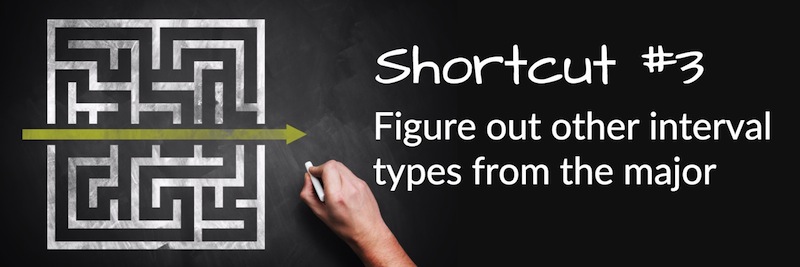
There are other intervals beyond those in the major scale. Do you need to learn those too?
The answer is yes – but don’t make the mistake of thinking you need to memorise all the minor, augmented and diminished intervals as well as the perfect and major ones!
The reason we’ve focused on the major scale above is that you can derive the other interval spellings from this framework.
For example: If you know the major interval spelling, then you can figure out the minor spelling just by reducing the accidental on the top note by one. “C up to E is a major third” becomes “C up to E♭ is a minor third”, and so on.
Likewise, you can derive augmented and diminished fourths and fifths by raising or lowering the perfect interval spelling by one.
We won’t go into more detail here. In most musical circumstances, just knowing how to get the minor intervals from the major scale ones you’ve learned above will be enough.
Shortcut #4: Don’t re-learn descending intervals
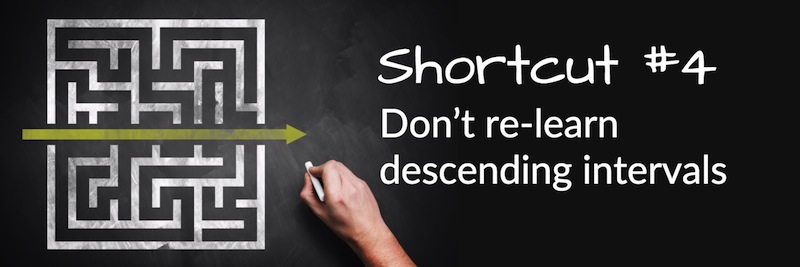
So far we’ve only talked about ascending intervals, for example “What is a major third above a C?”. What about if you need to know a descending interval, like “What is a major third below a C?”
You don’t need to memorise all of these as well. In fact you have two options to re-use your existing knowledge to find the answer.
Firstly, you can reframe the question and you may find you already know the answer: “What note is C a major third above?”. If you’ve just been learning the intervals ascending from A♭, the answer might pop into your head – “Oh yes, A♭ was the root note where the major third above came out as a C”.
It’s a bit like the game show Jeopardy: start from the answer, and might find you know the question.
The other option is to use the inversion trick. Each interval type pairs up with a corresponding inversion, meaning that going up by one interval brings you to the same note as going down by the other (just in a different octave). For example, perfect fourths and perfect fifths are inversion pairs, so going up a perfect fourth from a C takes you to an F, just like going down by a perfect fifth from a C takes you to an F.
Learn the inversion pairs and you can immediately transform any descending interval task into a corresponding ascending one.
The size of interval changes like this:
- Unison ←→ Octave
- 2nd ←→ 7th
- 3rd ←→ 6th
- 4th ←→ 5th
- 5th ←→ 4th
- 6th ←→ 3rd
- 7th ←→ 2nd
and the quality of the interval in an inversion pair changes like this:
- Perfect ←→ Perfect
- Major ←→ Minor
- Augmented ←→ Diminished
For example if you know the spellings for a major third ascending, you know the spellings for a minor sixth descending. Or if you know what a perfect fifth above an F♯ is you know what a perfect fourth below an F♯ is too!
Learn the simple inversion pair rules above and you’ve just doubled your knowledge of interval spellings.
Shortcut #5: Don’t waste time with enharmonics

An enharmonic is another name for the same note pitch. For example, E♯ and F are an enharmonic pair because raising E by one semitone brings you to the same pitch as F. Likewise C♭ and B: the two notes have the same pitch but different names.
This is useful for interval spelling but don’t use it the wrong way!
You might think that if they’re the same pitch then they are interchangeable. In some musical tasks, such as playing the right notes on your instrument, that might work fine. But in others, such as writing music correctly in staff notation, it matters very much whether you write an E♯ instead of an F, or a C♭ instead of a B.
Where you can take advantage of enharmonics is to recognise that by memorising the interval spellings for one root note, you can easily derive the correct spellings for any note enharmonic to that. You will need to adjust the spelling, but you don’t need to start from scratch with the accidentals.
For example, if you know all your major intervals starting from an F♯, don’t waste your time memorising them for G♭ too! Just use your F♯ knowledge and adjust accordingly. For example, to find a perfect fifth above a G♭ when you know that the perfect fifth above an F♯ is a C♯: the letter name must increase by one (F to G, so C to… D) and the result must be enharmonic with C♯: so you will need a D… flat! A perfect fifth above G♭ is a D♭.
(Of course if you memorised the rules from Shortcut #1 above you knew that already, right?)
Shortcut #6: Develop your own toolkit

So far we’ve introduced five different ways you can speed up learning to spell intervals. You might be feeling a bit overwhelmed!
Don’t worry. You don’t need to master all of these techniques. In fact, learning even just one or two can considerably speed up the learning process for you.
Try to develop your own set of tools and shortcuts that make sense to you. You might be a natural born memoriser and prefer to simply learn the correct spellings by rote from the table above. You might already know about interval inversions, so the inversion trick above is instantly helpful. You might like to learn the rules of thumb for determining accidentals, to save you counting out semitones – or perhaps you happen to be quick with the semitone approach so those rules don’t help as much.
Which shortcuts are useful to you will depend on your musical background and learning style. Make sure you understand each of them so you can make an informed choice, but then it’s up to you to decide which go in your toolkit.
Shortcut #7: Learn the spellings gradually
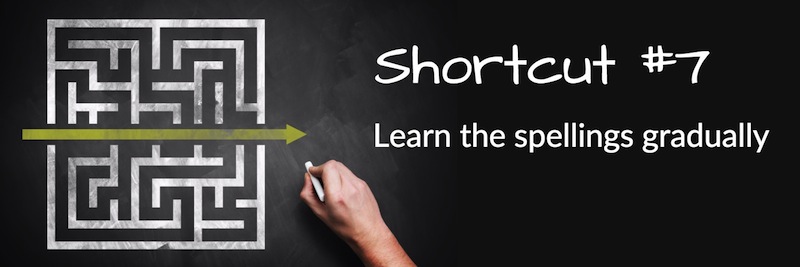
Probably the biggest mistake you can make with learning to spell intervals is to try to learn it all at once. So how should you approach it?
The answer is to gradually increase the set of spellings you expect yourself to know. This might seem counter-intuitive to the overall goal of learning to spell intervals fast, but sometimes the fastest way to reach your goal is with small, consistent steps forward.
Depending on the toolkit you’ve assembled, that might mean:
- Starting with a few keys and memorising the major interval spellings, perhaps C, F and G to begin with. You can go quite far with just those because you know how to quickly derive spellings for C♭, C♯, G♭, G♯, G♭, and G♯ too (just adjust the accidental by a half step), as well as the descending intervals from those notes.
- Starting with just a few interval types, using the rules of thumb from Shortcut #1 above: learn the rule for perfect fourths, for example, and now you can spell a perfect fourth above any note. With the inversion trick, you can spell a perfect fifth below any note too!
- As recommended above, starting with just the intervals of the major scale. Then you can use simple adjustments to instantly figure out the other interval types such as minor, augmented and diminished.
How to spell intervals fast

As you’ll remember, our overall goal is to get instant recall of interval spellings. All of the tips and shortcuts above help you to quickly learn how to spell intervals. So how do you learn to spell intervals quickly?
The answer is that by using the process above in your daily musical life you will automatically start to memorise the spellings. You might choose to actually sit down and memorise some spellings, but you don’t need to work hard to memorise them all. You can use the step-by-step approach explained here, along with the various tricks and shortcuts to make it faster, as a way to gradually familiarise yourself with all of the interval spellings.
It will soon become second nature to answer questions like “What’s a minor third below a D♭?” or “What’s the interval between an A and a G♯?”. You won’t need to think through the steps: you’ll have naturally passively memorised the answer and it will come to mind immediately.
Remember that all of this knowledge is only useful if you use it. Don’t just sit down with a pen and paper, trying to memorise these spellings for the sake of it. Find ways every day to use your interval recognition and spelling skills to play music by ear, improvise, transcribe, or compose your own music. Every opportunity you find to practice spelling intervals in a meaningful way will bring you one step closer to being able to instantly spell any interval you hear.

